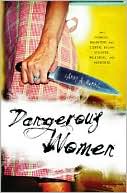When I was approached by my agent, Claire Gerus, to write a book about women who commit violent crimes, I spent a long time considering her proposal. I had concerns. Sure I had been working as a clinical and forensic psychologist for over three decades and had lots of experience with women who murder, maim, and molest. But most people think of men, not women, when they think of violent criminals.
Even though a couple of my previous books, Males at Risks: The Other Side of Child Sexual Abuse (1989, with co-authors Bolton and MacEachron) and The Heterosexual Male: Lust  in His Loins, Sin in His Soul? (1997), explored issues of interpersonal violence from a male’s perspective, the controversial finding that males can be victims of child sexual abuse and other violence perpetrated by females was also examined.
in His Loins, Sin in His Soul? (1997), explored issues of interpersonal violence from a male’s perspective, the controversial finding that males can be victims of child sexual abuse and other violence perpetrated by females was also examined.
Over the years I received both praise and condemnation for suggesting that girls and women sexually abuse children, especially boys, at a rate much higher than “official” reporting statistics documented. The voices of condemnation were the loudest and most persistent.
Even now, w ith the media full of stories about attractive female teachers molesting grade-school boys, I am dismayed by the number of voices who try to minimize the rape of male children by female teachers by calling it something else—an affair. Even some of my male friends and colleagues joined the chorus of gender-biased sexual expectations with a refrain straight from the male socialization hymnbook: “Oh Lord! Where in the hell were these women when I was in grade school?”
ith the media full of stories about attractive female teachers molesting grade-school boys, I am dismayed by the number of voices who try to minimize the rape of male children by female teachers by calling it something else—an affair. Even some of my male friends and colleagues joined the chorus of gender-biased sexual expectations with a refrain straight from the male socialization hymnbook: “Oh Lord! Where in the hell were these women when I was in grade school?”
If I decided to write a book about mothers, sisters, and daughters who assault, commit murder, and sexually abuse children, I knew I would be sticking my neck out again, even further this time, by exposing the darkest of the dark side of femininity. I knew I again would be faced with proponents of the pervasive cultural stereotype that women are victims, not perpetrators, of interpersonal violence. The voices of dissent would be back. In force. And, as my thirty years of experience as a clinical and forensic psychologist taught me, some women can be very dangerous.
One of my colleagues, a victim of a female stalker, suggested I should pack “heat” like she does, if I decided to write the book and make public appearances. “Don’t leave home without it,” she quipped. “And wear your body armor,” she added.
As a forensic psychologist, I have evaluated hundreds of violent criminals and  testified in court numerous times. The most frequent cases involve questions about the defendant’s competency to stand trial and/or issues of insanity. Competency generally refers to an accused’s ability to understand legal proceedings and to assist legal counsel in his or her own defense. While most people think insanity is a mental-health term, it is a legal term in the courtroom and, in most states, is defined by an individual’s ability to know the difference between right and wrong at the time he or she committed the crime.
testified in court numerous times. The most frequent cases involve questions about the defendant’s competency to stand trial and/or issues of insanity. Competency generally refers to an accused’s ability to understand legal proceedings and to assist legal counsel in his or her own defense. While most people think insanity is a mental-health term, it is a legal term in the courtroom and, in most states, is defined by an individual’s ability to know the difference between right and wrong at the time he or she committed the crime.
For example, a murderous mother could suffer from a serious mental illness, but if she knew what she was doing when she killed her children was wrong, she is not insane according to the law.
Because the interface between law and psychology in insanity defense cases is often like a bad marriage, forensic mental health experts often squabble about their differing opinions.
It is also common for forensic mental-health experts to evaluate defendants in order to assess their risk for committing additional violent crimes and the defendant’s chances of responding favorably to psychotherapeutic intervention.
As a clinical and forensic psychologist I have been able to draw from both areas of expertise to address these very important questions.
In spite of society’s tendency to view most female and male criminal behavior differently, I attempt to handle all forensic cases with the same level of objectivity and dedication as any criminal case, regardless of gender. I ask the referral source the same questions about the purpose of the evaluation, review countless documents related to the case, conduct incisive interviews with the defendant, and consult to the referral source about my evaluation findings and opinion about the case. I also interview others related to the case, if appropriate; administer psychological tests, if helpful; write a report, if requested; and testify in court, if summoned.
Some fore nsic cases require a fairly quick evaluation and a brief interaction with the court. Many require countless hours of work and lengthy adversarial encounters. Case files can fill a warehouse. Interviewing defendants and others associated with a case can go on for hours. Court testimony can stretch into days. Even though forensic work can be grueling, I always look forward to the next interesting and challenging cases.
nsic cases require a fairly quick evaluation and a brief interaction with the court. Many require countless hours of work and lengthy adversarial encounters. Case files can fill a warehouse. Interviewing defendants and others associated with a case can go on for hours. Court testimony can stretch into days. Even though forensic work can be grueling, I always look forward to the next interesting and challenging cases.
As a clinical psychologist, I specialized in treating victims and perpetrators of interpersonal violence, especially child sexual abuse. My clinical work helps me understand both sides of the tragedy of trauma. Seeing the terrible damage done by childhood abuse, I am not surprised when I find a history of trauma in my forensic cases. And, yes, more women are victims than men.
As I continued to consider my agent’s book proposal, I thought about presenting cases of girls and women who murdered and/or committed sexual crimes with an eye toward understanding and prevention. I opened my forensic files of dangerous women to see what I could find. Their stories were compelling. I decided to write the book. We settled on a title: Dangerous Women: Why Mothers, Daughters, and Sisters Become Stalkers, Molesters, and Murderers. It has been released to the public. Should I strap on a new set of body armor? . . .
Larry A. Morris, Ph.D. is a clinical and forensic psychologist who has been in private practice for more than thirty years. He is the author of four books including The Male Heterosexual, plus book chapters in A New Psychology of Men and Adult Survivors of Sexual Abuse. Dr. Morris lives in Tucson, Arizona.
























7 comments:
I can't wait to read this book and I am going to look for it this weekend.
Without giving too much away from your book, can you tell us what, if any, are the primary differences between men and women perps??
Leah: Thank you for your interest in Dangerous Women. I hope you found a copy. Your question, "What, if any, are the primary differences between men and women perps?" depends a lot on the type of crime. While each case should be analyzed individually, here are some examples of a few differences often seen between men and women who murder. Women most often kill intimates and acquantances, while men are less discriminating. Women usually kill by cunning (poison is a favorite)instead of brute force and usually conceal evidence of their crime(ditch the bottle) but not the body ("He just keeled over and I don't know why."). While rage and control may be part of the motivation, women usually kill for some kind of profit (e.g., insurance money, property). And women, especially serial killers, usually get away with murder longer than men. Some statistics say twice as long or much longer.
I hope these examples help answer your question. If you don't find answers to the rest of your questions in Dangerous Women, feel free to contact me.
Again, thanks for your interest in my work.
I am wondering if you find a difference between men and women offenders in terms of rehabilitation?
What differences have you found, if any, in terms of recovery between male and female victims of abuse.
Also what is your opinion on the cause of sociopathy?
Can't wait to read this book! I for one am very glad you decided to write it!
d:
In my experience the major differences leading to success in rehabilitation of male or women offenders is not so much gender but the individual's history of offenses (the more compulsive the behavior the more difficult the rehabilitation),the ability to assume responsibilty for their behavior, and a genuine motivation to change.
Therapists who work with male victims have learned to be more gender sensitive in their approach. Most males eschew the victim role and may present with a denial of victimization although their emotional problems are steeped in childhood tauma. Breaking that barrier is often more difficult with males than females who may more easily acknowledge a history of trauma. In my experience, successful therapists look at offenders or victims as individual cases and employ gender sensitive strategies when appropriate but do not rely on gender sterotypes.
If I knew the cause of sociopathy I could win the Nobel Prize. Lots of theories but nobody knows for sure. I discuss some excellent research in Dangerous Women which points to two types of antisocial behvavior:One type may be related to a neurodevelopmental disorder and the other may be related more to social relationships. Males seem to fall into the first category, while females tend to fall into the second. Dr. Robert Hare believes that psychopathy is the result of a complex and poorly understood interplay between biological factors and social forces. His presentation in Without Conscience is compelling and consistent with my experience.
I hope you enjoy Dangerous Women.
Larry A. Morris, Ph.D.
Dr. Morris,
Thank you for your reply. I have your book on order and I am very eager to get it. I will also order Dr. Hare's book.
What do you think of Samenow's work with sociopath's and his theory of choice in their behavior?
This will be my last question, I promise.
Hi d:
Never fear asking questions. Your question about Samenow's work is another good one.
For decades Stanton Samenow's position that criminals are criminals simply because of the way they think has been controversial. I agree with Samenow that most criminals have serious problems with their thinking and rehabilitation should include some form of "rethinking" process. Many sex offenders exhibit cognitive distortions about their criminal sexual behavior and its impact on their victims. The distortions often provide a justification for acting out. For exammple, one sexual offender told me that when a three-year-old girl lifted her dress and showed him her panties, she was asking for sex! An immportant component of most successful treatment programs for sexual offenders includes a focus on identifying and changing the cognitive distortions.
As you will see in Dangerous Women, I also agree with his position on early intervention as a means of prevention, although the focus may be different.
On the other hand, I do not accept Stanton's rejection of biological, socialization, or trauma as factors in how the criminal thinks. He continues to assert that crime resides within the mind of the criminal but admits that he doesn't know why. While not conclusive, most research points to neurobiology and environmental factors as strong contributors to criminal behavior.
I hope this helps in your pursuit of understanding the criminal mind.
Larry A. Morris, Ph.D.
I am learning so much from you, Dr. Morris!
After reading Samenow's book I was left with two questions which your reply helped answer. Or at least suggested an answer.
1.Isn't the arrogant attitude displayed by a criminal, as described by Samenow, a personality disorder in itself?
and,
2. The criminal may 'choose' crime as a way of life but the personality traits that lead him to this choice suggest to me a personality disorder.
Neurobiology could certainly be one reason or cause of this disorder, I think.
I am so looking forward to the arrival of your book.
Thank you again for taking the time to answer my questions.
Post a Comment